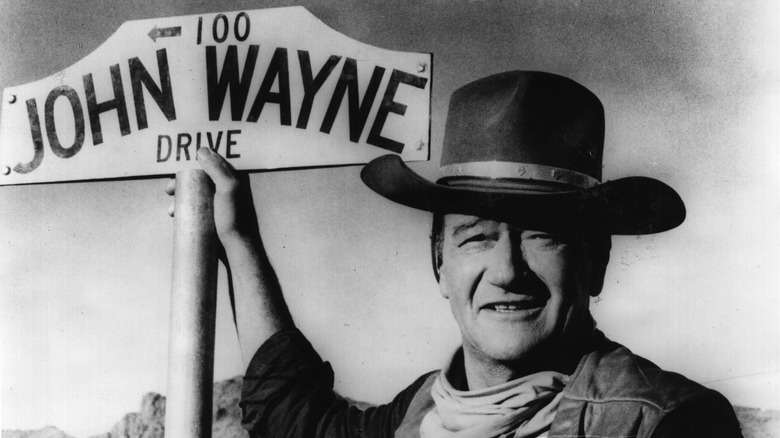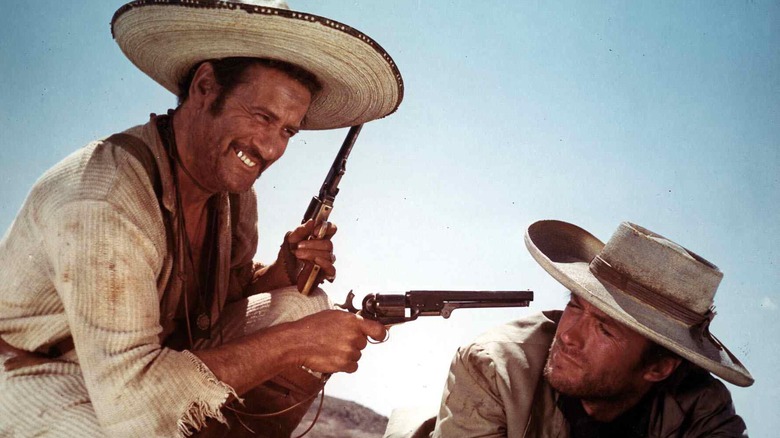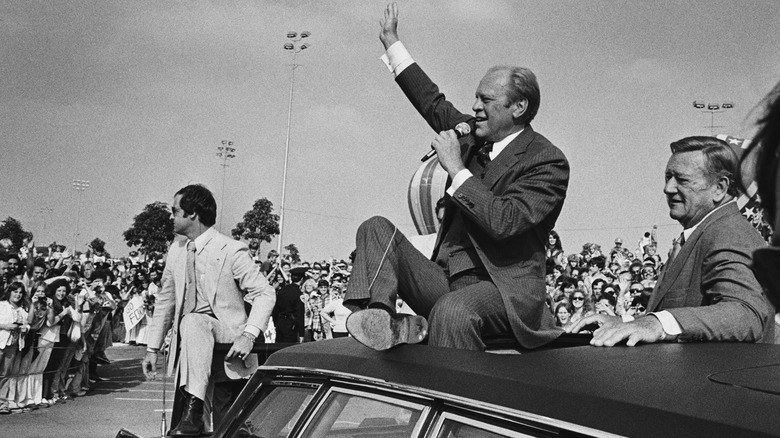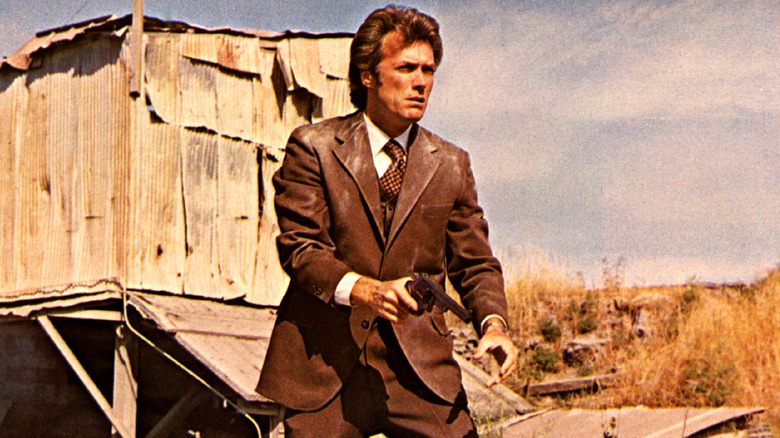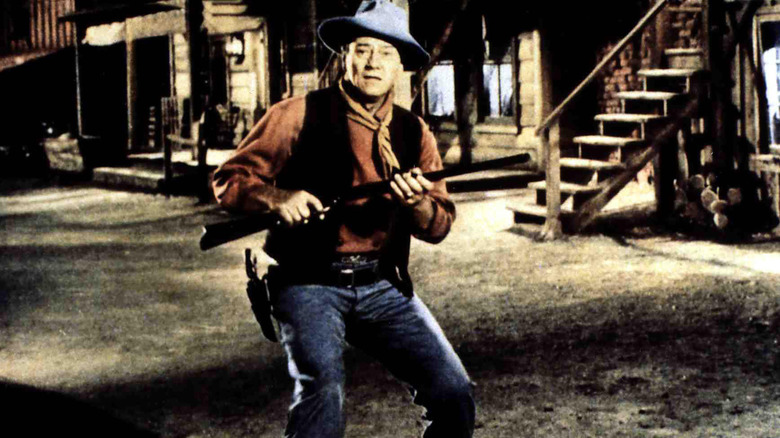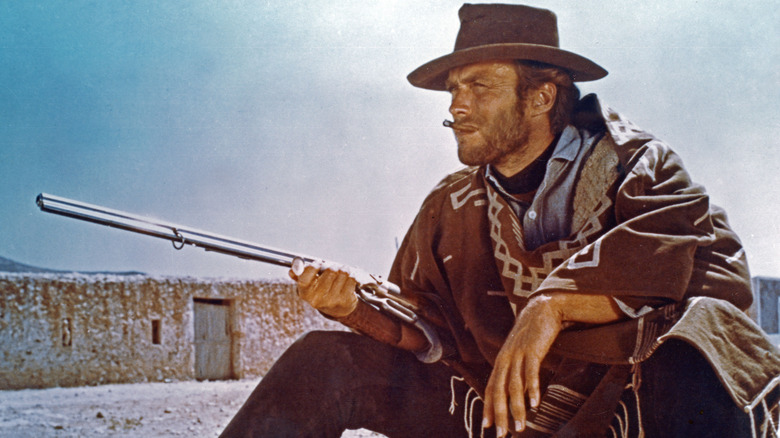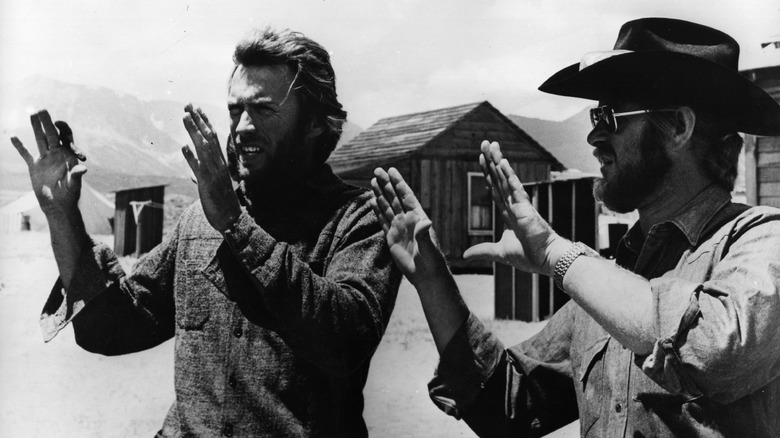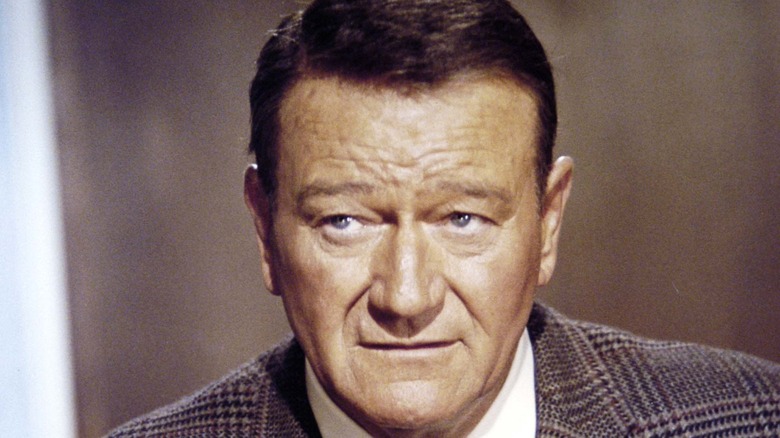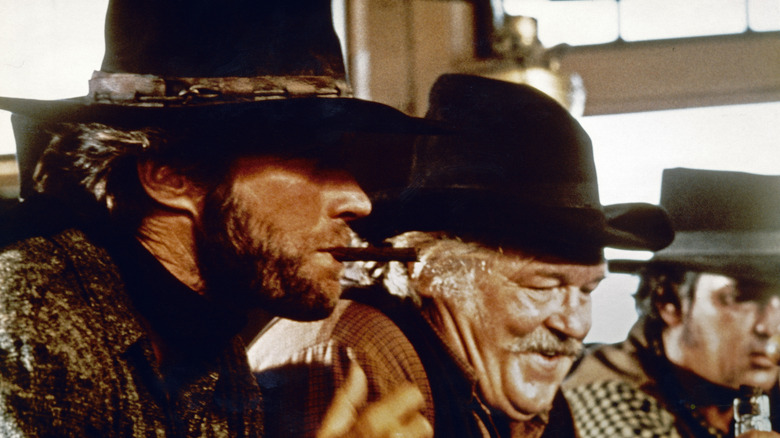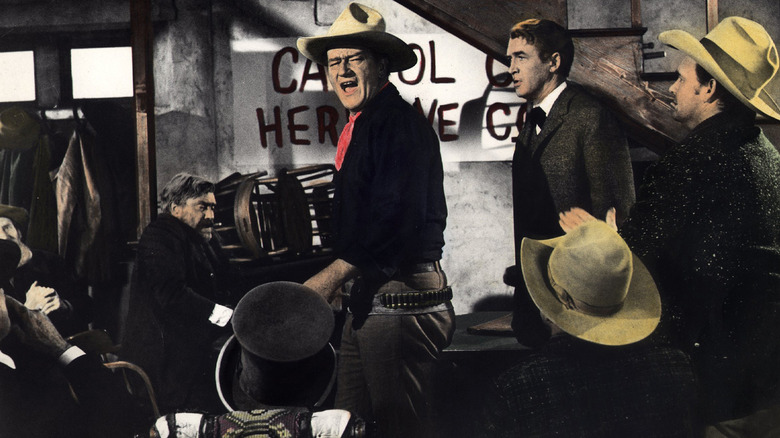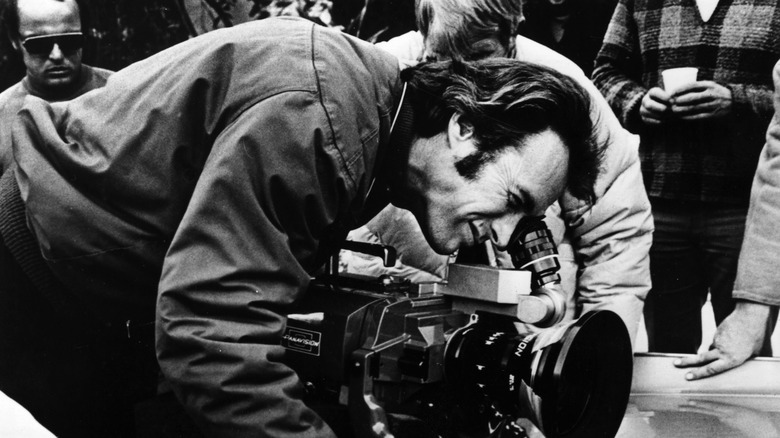The Truth About John Wayne And Clint Eastwood's Relationship
Two Western icons walk into a saloon, one is John Wayne and the other Clint Eastwood ... at least in our fantasies, since the two never did bless the masses with their idyllic jaw lines and enviously masculine dispositions side-by-side. And why not? Wasn't Hollywood grasping at straw bales to get these legends in a quick draw together? Probably. But that oat opera never was because in the end, Wayne, aka The Duke, and Eastwood were perhaps just a little too big for their britches to be co-stars.
But these two beloved leading men shared a slew of similarities even if they decidedly never worked together. Both never planned to quit working — Wayne's last picture, "The Shootist," was in 1976, three years before his death, and Eastwood is still making films, notes Variety, at 91 years old. Both were conspicuously involved in politics: Eastwood was the mayor of Carmel, California, from 1986 to 1988, while Wayne was never shy about his endorsements for the GOP (nor Eastwood for that matter with his memorably weird chair bit at the 2012 Republican National Convention). And John Wayne and Clint Eastwood have remained seemingly timeless from the numerous classics that have graced the silver screen. With so much in common, its a little bittersweet that they never teamed up and shot a bunch of outlaws like the good people always wanted.
John Wayne wasn't hot on Spaghetti Westerns
By the time Clint Eastwood came on the scene with the TV series "Rawhide" in 1959, John Wayne was just digging his spurs into an already legendary career. As Eastwood was sharpening his acting chops as Rowdy Yates for the next eight years, Wayne was making plenty of classics, including "The Alamo" and "The Man Who Shot Liberty Valance," per History. Then in 1965 while Eastwood was on a break from "Rawhide," he was offered to star in a Western with an up-and-coming Italian director in Spain. As Eastwood recalled on the Actor's Studio, "Sergio Leone didn't speak any English and I didn't speak any Italian, so, I was kind of on my own," when it came to the direction on "A Fistful of Dollars."
It was the first Western of its kind. The dialogue was thin, the main character had no name and lacked the usual charm required from the protagonist. It was a box office hit, and not just in Italy. It was immediately made into a trilogy, with "The Good, the Bad and The Ugly" leaving a lasting imprint in the world of Westerns thereafter, per Britannica. Despite its success, Wayne was evidently uninterested in working with Leone, although he didn't come right out and say it. Wayne just didn't ever consider having Leone direct any of his pictures, even as they sifted through a number of directors for "Rooster Cogburn" before landing on Stuart Millar, who was unquestionably inexperienced and not well liked by Wayne, per "John Wayne: The Life and Legend."
John Wayne was excited to meet Clint Eastwood on account of his Politics
According to "John Wayne: The Life and the Legend," John Wayne and Clint Eastwood first met in person on the set of "The Shootist" in 1976. Ron Howard, a co-star in the film, said that when Wayne heard the "Dirty Harry" star was coming to visit, he inquired about the man's politics. Wayne was pretty isolated in Hollywood as a stout conservative, although he said in an interview that he had always considered himself a liberal of sorts and was actually surprised to hear from others that has was a "right-wing conservative extremist." He also spoke in another interview about how he voted for Democrats on occasion, saying that "I vote for the man."
Eastwood also shared this sentiment, at least from a 2020 interview with the Wall Street Journal, in which he spoke about being a libertarian as "somebody who has respect for other people's ideas and is willing to learn constantly." However, Wayne's homophobic comments and belief in white supremacy "until the blacks are educated to a point of responsibility" in a 1971 Playboy interview are most likely what permanently labeled the Academy Award winner as a conservative, if not a right-wing extremist. Whether it was from the Duke's point of view on civil rights, or merely having an open mind about political leaders, when he heard from director Don Siegel that Eastwood was a conservative, he was enthusiastic about meeting him.
John Wayne never got to Go Ahead and Make Our Day...
John Wayne was originally offered the lead part in "Dirty Harry" and later regretted turning it down, according to "John Wayne: The Life and Legend." According to Clint Eastwood's interview on the Actor's Studio, the actor heard that Paul Newman was also offered the part but wasn't interested due to some of its political undertones. So, Eastwood being the next runner-up was cast as Inspector Harry Callahan in 1971, and the film went on to be a wildly successful franchise. While the critics tore it apart for its excessive violence and glorification of a bad cop, the box office raked in $22 million dollars, according to "Clint Eastwood: A Biography." The film became a classic, and its sequels continued to do well with Eastwood directing the fourth and final of the series, "Sudden Impact."
"I made a mistake with that one," Wayne said per his biography, despite being opposed to the excessive violence in films, or a law-upholding character using questionable tactics to get the bad guy. It probably turned out for the best, given that Eastwood was already well suited to play a cop that would shoot a maniac in the middle of a crowded city street. Or challenge a man in that classically gritted voice to "Go ahead, make my day." Or, the fact that Eastwood did most of his own stunts in his films, reports The Independent, and Wayne's health was quickly declining at that time.
John Wayne wouldn't shoot a man in the back, but Clint Eastwood certainly would
According to "John Wayne: The Life and Legend," the Duke was not impressed with much of Don Siegel's direction on "The Shootist." From how he set up the shots to his blocking instructions, John Wayne often gave the petite director what-for. But this could have had something to do with Siegel telling a reporter for the Carson City newspaper that "Wayne is supposed to eat directors for breakfast, but if he tries to eat me, he'll get indigestion."
Siegel also had to shoot a handful of scenes around Wayne while he was recovering from a bronchial infection. When the lead returned, most of what the director did while he was gone was okay, except for a scene where Wayne's stunt double shot a man in the back as he attempted to run out of the saloon. According to his co-star Hugh O'Brian, Wayne said, "Wait a god**** minute! I've never shot anybody in the back and I'm not going to start now." Many years later in Eastwood's interview on the Actor's Studio, he'd heard that when Siegel was directing Wayne in another scene, the director told him to shoot the villain as he was sneaking up on him. When the Duke refused yet again to shoot a man in the back, Eastwood said that Siegel quipped, "Clint Eastwood would have shot him in the back," to which Wayne replied, "I don't care what that kid would've done, I don't shoot him in the back."
Clint Eastwood liked Antiheroes, while John Wayne stuck to the Good Guy
Clint Eastwood's characters undeniably shook up the format of American Westerns. The straightforward good guy and bad guy dynamic became more ambiguous, and therefore, far more interesting. Eastwood's protagonists often fueled the plot with vengeance, like in "The Outlaw Josey Wales," while John Wayne's were justly upheld by honorable ethics, like in "El Dorado." Eastwood's characters also seemed to directly reflect the new approaches to morality and cinema in the 1970s. Wayne's ideals were cultivated 30 years prior, and his convictions oftentimes appeared black and white for right or wrong.
In Wayne's Playboy interview, he talked about the dwindling state of democracy due to American's growing disrespect for authority, such as the Black Panthers treatment towards police and the Vietnam War protests. He was also candid about his thoughts towards pictures that veered off course from traditional Western frameworks, like "High Noon." In the film, a retired marshal has to face an outlaw gang alone after the townsfolk refuse to help him. In the end, the character prevails but throws his badge in the dust before hopping in a carriage to leave town with his new wife. Wayne told the interviewer, "It's the most un-American thing I've ever seen in my whole life." But for Eastwood, moral dilemmas, ambiguous endings, and the supernatural were far more interesting, like his choices to direct and star in undeniably unique Westerns like "High Plains Drifter" and "Pale Rider," per the Actor's Studio.
John Wayne wasn't as friendly to new people in the business
John Wayne preferred working with the best in the business since he seemed to consider himself as such. If it wasn't John Ford, directors needed to be as well-rounded as they were well-experienced in their careers, per "John Wayne: The Life and Legend." He loudly detested Stuart Millar, who directed him and Katharine Hepburn in "Rooster Cogburn," saying on Phil Donahue, "He was a poor director. Well, he was kind of new in the business, and there's some questions about ... his capabilities."
This was also the case for actors, and he gave his "True Grit" co-star Kim Darby no slack for what he thought was a lackluster performance in the 21-year-old's first major role— despite that Wayne finally won an Oscar from it. Per the Actor's Studio, Clint Eastwood began directing in 1971, his first film being "Play Misty For Me," which wasn't a Western. So when he propositioned Wayne with a co-starring role with him in "The Hostiles" in 1973, it's not a surprise that Wayne was uninterested. On top of that, Wayne really wasn't a fan of Eastwood's first directed Western that same year, "High Plains Drifter," per Wayne's biography.
John Wayne was a little hostile about The Hostiles
According to "John Wayne: The Life and Legend," when the script for "The Hostiles" came to Clint Eastwood's production company, Malpaso, Eastwood sent it over to John Wayne to see if he'd want to co-star in the film with him. The story (which Eastwood admitted needed some work) was about a younger guy who won half of a ranch that was owned by an older guy. The two unsurprisingly don't get along swimmingly but in the end have to work together to fight off a band of hostiles that come to take over the property. The Duke politely declined the offer and sent the script back. After Eastwood sent the script to Wayne a second time, Wayne replied to Eastwood with his unfavorable opinion about "High Plains Drifter," notes Screen Rant.
Wayne was given a third draft while he was out sailing. This time it came from his son, Mike Wayne, who thought his dad should really consider the role. When Wayne flipped through the first few pages, he gave it a "This piece of s*** again" and threw it into the Pacific. According to a Wayne biography, "Duke, a Love Story," he told a colleague, "This kind of stuff is all they know how to write these days ... someone like me and Eastwood ride into town, know everything, act the big guys, and everyone else is a bunch of idiots." Eastwood never went on to make "The Hostiles."
John Wayne wasn't a fan of High Plains Drifter and let Clint Eastwood know it
Rather than responding to Clint Eastwood's second attempt to entice him with a part in "The Hostiles," the "Rio Grande" star responded to the new director with his dissatisfaction of his work on "High Plains Drifter." John Wayne wrote to Eastwood that the townspeople did not "accurately represent the spirit of the pioneers who had made America great." The film's director understandably did not reply, per "John Wayne: The he Life and Legend." Eastwood later said in an interview with Kenneth Turan (via "Ride, Boldly Ride: The Evolution of the American Western), "I realized that there's two different generations, and he wouldn't understand what I was doing. High Plains Drifter was meant to be a fable; it wasn't meant to show the hours of pioneering drudgery. It wasn't supposed to be anything about settling the West."
And Eastwood was right. The film's no-named protagonist (played by Eastwood, naturally) is mysterious, devious, and not necessarily likeable, considering he kills three guys and assaults a woman on his first day in town. Considering that Wayne's idea of a hero was more like his Sheriff John T. Chance in "Rio Bravo" or the revered patriot Davy Crockett in "The Alamo," it's not a huge surprise that "High Plains Drifter" wasn't his cup of tea. The movie did alright at the box office despite the Duke's criticism, doing over $15 million in sales. Not bad for Eastwood's first Western.
John Ford made John Wayne, but he was Clint Eastwood's inspiration
John Wayne had incredible loyalty to the man who made him the icon known today. John Ford taught him everything he knew, from his famous walk to the charming intonation in which all of Wayne's characters spoke. Wayne even called him coach, per "John Wayne: The Life and Legend." However, Ford put a lot of pressure on Wayne no matter the circumstances, whether it was humiliating him on set or berating him for not enlisting during World War II, per PBS. But despite the tensions that ebbed and flowed between the two icons, Wayne was always loyal to Ford and openly referred to Ford's advice often when he was on other sets, from how to sequence a shot to the rhythm of delivering emotion in a scene.
Eastwood also held Ford in high regard and was inspired by the director throughout his own career. During an event at the Directors Guild of America, Eastwood said that Ford's influence on directors "is like osmosis," and that he watched Ford's films like "Stagecoach" in the theater as a kid, "sometimes twice in a row." But for the "Josey Wales" star, Ford's equations for Westerns were simply jumping off points rather than rules to abide. As Eastwood's career began developing in the 1960s, Hollywood was already tampering with plots and archetypes, per The Evolution of the American Western. He was drawn to this transition and enjoyed the depth required to cultivate heroes that weren't necessarily straightforward in their intentions or approachability.
As Clint Eastwood was winding up, John Wayne was winding down
When John Wayne had his one-sided exchange with Clint Eastwood over "High Plains Drifter," it was the early 1970s when Eastwood's career was on the upswing while Wayne's was on the down. Wayne had started to take roles he wasn't really interested in (like the title character in "McQ") for the sake of working, per his biography. On top of that, "The Searchers" star's health was declining quickly. Wayne recovered from lung cancer after a major surgery in 1964 but then started developing heart problems. On top of that, doctors found he had stomach cancer in 1975 right before filming "The Shootist."
Meanwhile, Eastwood had started his own production company, Malpaso, in 1967, and was receiving plenty of praise for his work across the board, per the Actor's Studio. In 1971, Eastwood received a Golden Globe for World Film Favorites, was named "The World's Favorite Movie Star" by Life Magazine, "Dirty Harry" was smashing the box office, and he directed his first film, "Play Misty for Me." This was just the start of a decade that would make Eastwood the highly respected icon known today. Now whether Eastwood's immediate rise to the top actually created tension with the Duke isn't completely known. But Wayne was a legend in his time, and one who was certainly used to dominating the Western corner of the industry until Eastwood came along.
